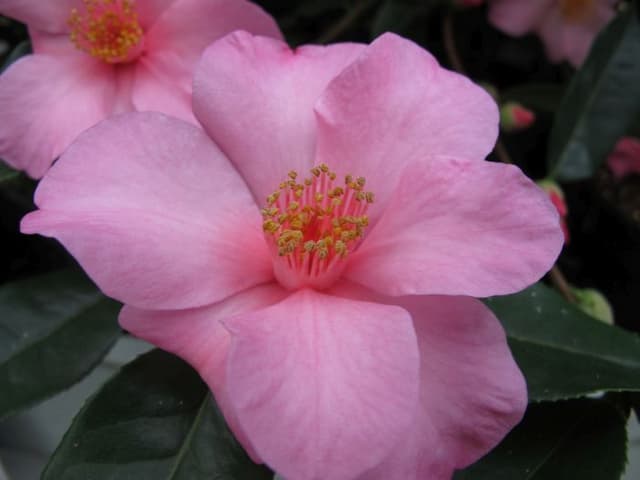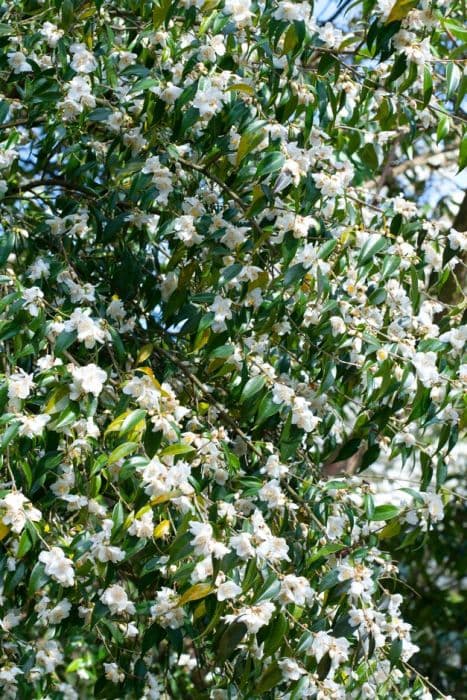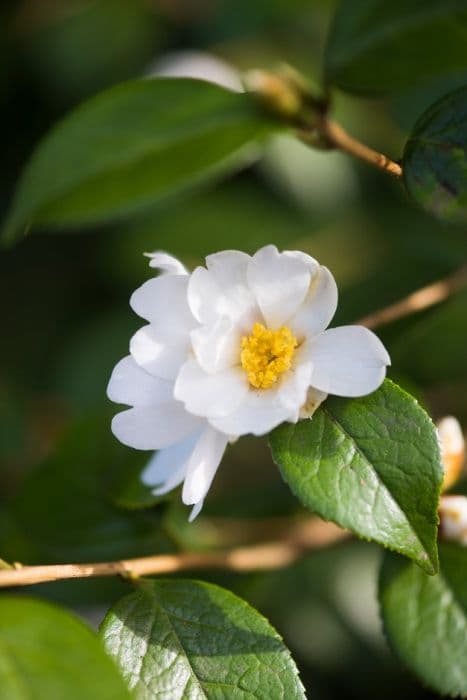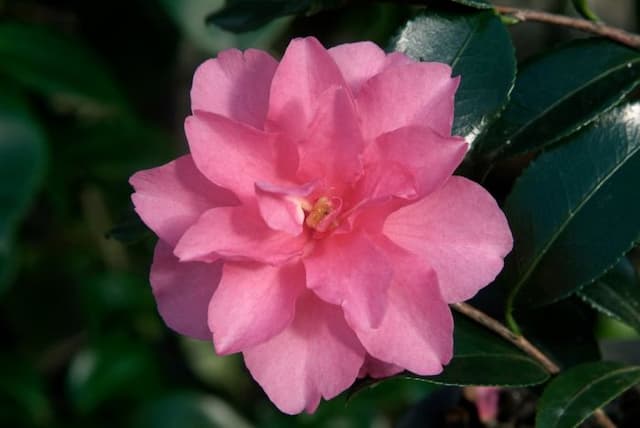Swan Lake Camellia Camellia 'Swan Lake'
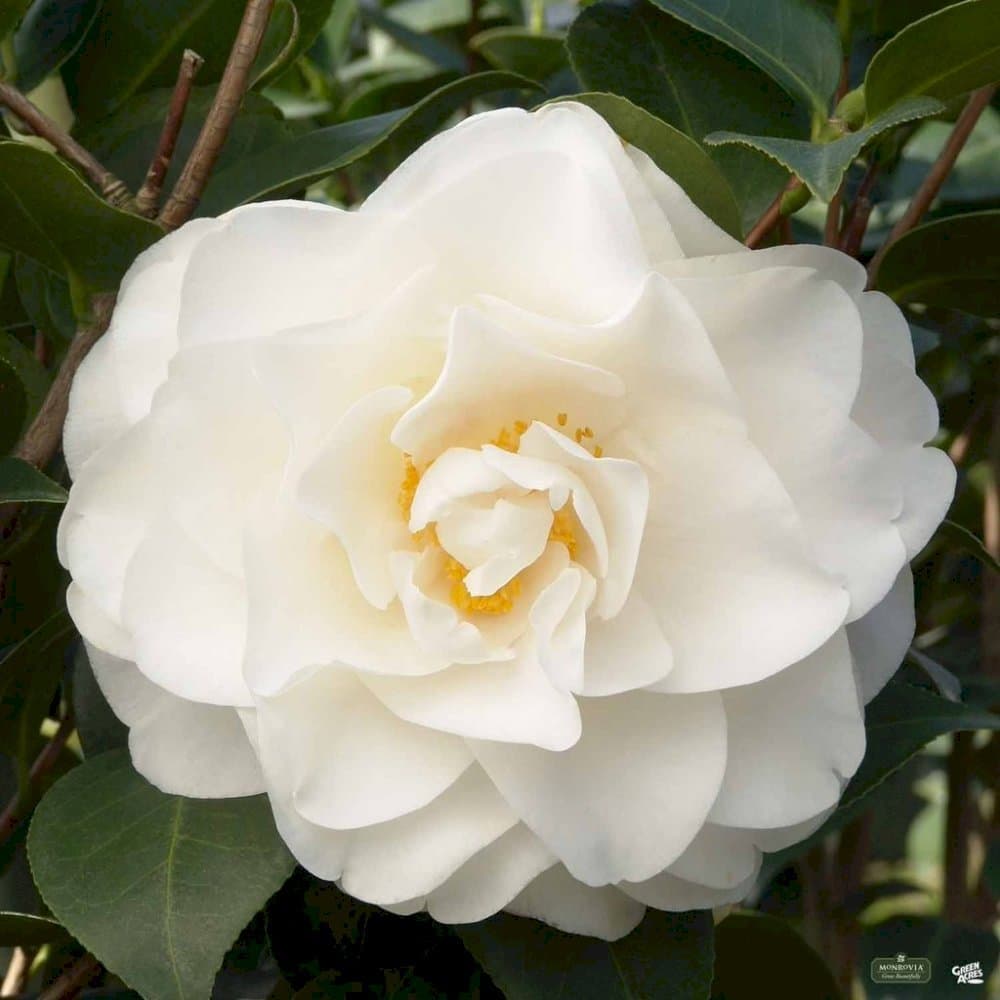
ABOUT
Camellia 'Swan Lake' is a spectacular flowering shrub known for its elegant white blooms that resemble the purity and grace of its namesake. The flowers of the 'Swan Lake' camellia are large and peony-shaped, consisting of multiple layers of delicate, ruffled petals that often have a subtle hint of pink, especially on the edges, as they unfurl. This tinge of color gives the blooms depth and dimension, setting them apart from other pure white flowers. The lush and glossy foliage of the 'Swan Lake' camellia creates a vibrant backdrop for its showy flowers. The leaves are leathery in texture, and a rich, dark green color, with serrated edges that can capture the light, creating a shimmering effect. When in bloom, the contrast of the bright flowers against the dark foliage makes for a striking display in the landscape. 'Swan Lake' camellias tend to have a growth habit that is both dense and spreading, allowing the plant to be an attractive hedge or standalone feature. Its branches are sturdy and well-structured, providing an excellent framework for the abundance of blooms. The blossoms not only are visually appealing but may also emit a faint, pleasant fragrance that attracts both the senses and a variety of pollinators to the garden. Overall, Camellia 'Swan Lake' is a captivating plant that brings a touch of refined beauty to any setting with its classic, pristine flowers and luxuriant greenery. Its ability to produce such a magnificent display without reaching towering heights makes it a versatile choice for many gardeners seeking to add charm and elegance to their outdoor spaces.
About this plant
 Names
NamesFamily
Theaceae
Synonyms
Swan Lake Camellia, Japanese Camellia
Common names
Camellia 'Swan Lake'.
 Toxicity
ToxicityTo humans
The Camellia 'Swan Lake', commonly known as the camellia, is not considered hazardous to humans. Typically, camellias are safe and are not known for being toxic or causing poisoning when touched or ingested.
To pets
The Camellia 'Swan Lake', which falls under the larger group of camellias, is generally regarded as non-toxic to pets. Consumption of this plant should not pose a risk of poisoning to cats, dogs, or other household pets.
 Characteristics
CharacteristicsLife cycle
Perennials
Foliage type
Evergreen
Color of leaves
Dark green
Flower color
White
Height
6-12 feet (1.8-3.7 meters)
Spread
5-10 feet (1.5-3 meters)
Plant type
Shrub
Hardiness zones
7
Native area
Asia
Benefits
 General Benefits
General Benefits- Ornamental Value: The Camellia 'Swan Lake' adds aesthetic appeal to gardens with its attractive blooms.
- Evergreen Foliage: It retains its glossy, dark green leaves throughout the year, providing constant visual interest.
- Long Blooming Season: This camellia species often enjoys a lengthy blooming period, offering flowers from fall to spring.
- Variety of Landscaping Uses: It can be used for hedges, specimen planting, or in flower borders, showing versatility in garden design.
- Tolerance to Shade: Unlike many flowering plants, Camellia 'Swan Lake' can thrive in partial shade, making it suitable for shaded gardens.
- Attracts Pollinators: The flowers can attract bees and other pollinators, supporting the local ecosystem.
- Resistance to Pests: It is generally resistant to pests and diseases, which makes it easier to maintain a healthy plant.
- Cold Hardiness: Camellia 'Swan Lake' can withstand cooler temperatures, making it suitable for a range of climates.
 Medical Properties
Medical PropertiesThis plant is not used for medical purposes.
 Air-purifying Qualities
Air-purifying QualitiesThis plant is not specifically known for air purifying qualities.
 Other Uses
Other Uses- Artistic Inspiration: Camellia 'Swan Lake', with its delicate white blooms, can serve as a muse for artists and poets seeking natural beauty and tranquility in their work.
- Wedding Decor: The flowers of the Camellia 'Swan Lake' can be used in bridal bouquets or as subtle and elegant decorations for weddings due to their pure white appearance and association with devotion and admiration.
- Culinary Garnish: Although not typically known for edibility, the petals of the Camellia 'Swan Lake' can be used as a decorative, non-toxic garnish for sophisticated cuisine.
- Natural Fabric Dye: The petals and leaves of the Camellia 'Swan Lake' may be used to extract natural dyes for coloring fabrics with a soft, subtle hue.
- Fragrance Extraction: The Camellia 'Swan Lake' can be utilized to create essential oils or fragrances for perfumery, offering a light, floral scent.
- Photography Subject: The striking appearance of Camellia 'Swan Lake' blooms provides a beautiful subject for photographers, especially in macro photography.
- Educational Tool: Camellia 'Swan Lake' can be included in horticultural education as a specimen to teach about plant biology, breeding, and hybridization techniques.
- Cultural Symbol: In certain cultures, Camellia 'Swan Lake' may be used symbolically in festivals or rituals to represent purity, love, or the coming of spring.
- Bee Attraction: While not an unusual use, Camellia 'Swan Lake' can play a role in supporting local bee populations by providing pollen when other sources are scarce in late winter or early spring.
- Companion Planting: Camellia 'Swan Lake' can be strategically placed in gardens to complement other plants with contrasting foliage or to create a desired aesthetic effect in landscape design.
Interesting Facts
 Feng Shui
Feng ShuiCamellia is commonly associated with perfection and excellence in Feng Shui, and 'Swan Lake' being a white variety can be used to bring purity, peace, and calming energy into a space. Place it in areas you wish to encourage a fresh start or new beginnings, like the east sector of a home for family harmony or the west to promote creativity and inspiration for children.
 Zodiac Sign Compitability
Zodiac Sign CompitabilityCamellias are not used in astrology practice.
 Plant Symbolism
Plant Symbolism- Admiration: Camellias generally symbolize admiration, respect, and affection, making them a perfect gift to express these emotions.
- Perfection: The 'Swan Lake' variety, with its pure white flowers, may represent the perfection and excellence one strives for in certain areas of life.
- Devotion: Often used in weddings, camellias can symbolize the enduring devotion between partners, suggesting a long-lasting bond.
- Beauty: The camellia, with its elegant appearance, is commonly associated with the beauty of a woman, including inner beauty and the beauty of life itself.
- Longevity: The longevity of the camellia flower, which can bloom throughout the winter, embodies the wish for a long and healthy life.
 Water
WaterCamellia 'Swan Lake', commonly known as Swan Lake Camellia, requires consistent moisture and should be watered deeply to encourage a deep root system. Water the plant with approximately 1 to 1.5 gallons of water per week, depending on climate conditions, but ensure that the soil is well-drained and not waterlogged. During hot, dry spells, increase the watering frequency to prevent stress. In the growing season of spring and summer, keep the soil moist but reduce watering in the fall and winter to avoid root rot. Always water at the base of the plant to avoid wetting the foliage which can lead to disease.
 Light
LightSwan Lake Camellia thrives in partial shade with protection from direct afternoon sunlight that can scorch its leaves. The ideal location offers it morning sunlight and afternoon shade, or filtered light throughout the day, which helps the blooms retain their color and prevents heat stress. Too much direct sun can reduce the plant's vigor and bloom quality, while too much shade can affect its flowering.
 Temperature
TemperatureSwan Lake Camellia prefers a temperate climate with temperatures ranging between 60 to 80 degrees Fahrenheit during the growing season. While it can tolerate minimum temperatures down to around 20 degrees Fahrenheit, it should be protected from frost and extreme cold. Ideal conditions are cool to moderate temperatures; extended periods of heat above 90 degrees Fahrenheit can stress the plant.
 Pruning
PruningPrune your Swan Lake Camellia to maintain its shape and encourage airflow, which prevents disease. Pruning is best done immediately after blooming in spring, but before the summer heat, to avoid cutting off the next year's buds. Remove any dead or diseased branches and thin out the plant to allow light into the center. Prune sparingly, as camellias do not require severe pruning.
 Cleaning
CleaningAs needed
 Soil
SoilCamellia 'Swan Lake' thrives in well-draining, acidic soil with a pH between 5.5 to 6.5. A mix containing 2 parts peat moss, 1 part perlite, and 1 part pine bark is ideal.
 Repotting
RepottingCamellias should be repotted every 2-3 years in the spring, before the growing season begins, using fresh acidic soil mix.
 Humidity & Misting
Humidity & MistingCamellias prefer a moderately high humidity level, around 40-60%, but they can tolerate lower humidity levels with adequate watering and care.
 Suitable locations
Suitable locationsIndoor
Provide bright, indirect light and keep soil slightly moist.
Outdoor
Choose partial shade, shelter from strong winds, keep soil moist.
Hardiness zone
7-9 USDA
 Life cycle
Life cycleCamellia 'Swan Lake', also known as simply Swan Lake Camellia, begins with seed germination, where environmental conditions such as temperature and moisture trigger the emergence of a root and shoot from the seed. The seedling stage follows, where initial leaves develop and photosynthesis begins, allowing the plant to grow and establish itself. As it enters the vegetative stage, the Camellia 'Swan Lake' grows leaves, stems, and branches, gradually maturing over several years. During the reproductive stage, it produces distinctive white flowers, usually starting from late winter to spring, which subsequently attract pollinators for fertilization. After pollination, the plant develops seed pods which, when mature, release seeds to complete the cycle. Finally, as the plant reaches maturity, it can produce flowers and seeds annually for many years, contributing to the species' survival.
 Propogation
PropogationPropogation time
Spring-Early Summer
The Camellia 'Swan Lake', commonly known as the Swan Lake Camellia, is best propagated through semi-hardwood cuttings. The ideal time to take these cuttings is in late summer, after the plant has finished flowering and new growth has begun to mature and harden slightly. To propagate, a cutting of about 4 to 6 inches (10 to 15 centimeters) in length is taken from healthy, disease-free growth. The leaves on the lower half of the cutting should be carefully removed, and the cut end can be dipped in a rooting hormone to encourage root development. Then, the cutting is placed in a potting mix composed of equal parts peat and perlite or sand, ensuring good drainage and aeration. The pot should be kept in a warm location with indirect light and covered with a plastic bag or placed in a propagator to maintain high humidity until roots develop, which typically takes several weeks to a few months. Regular misting and keeping the soil evenly moist, but not waterlogged, is crucial for successful rooting.
